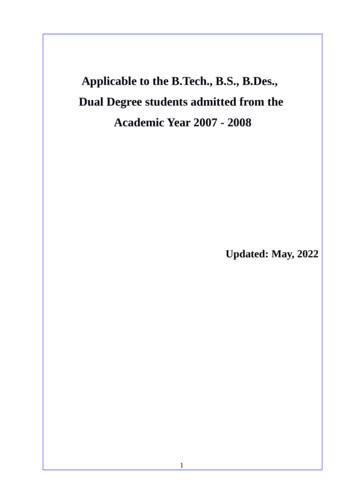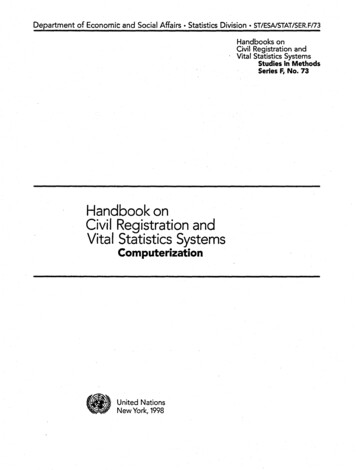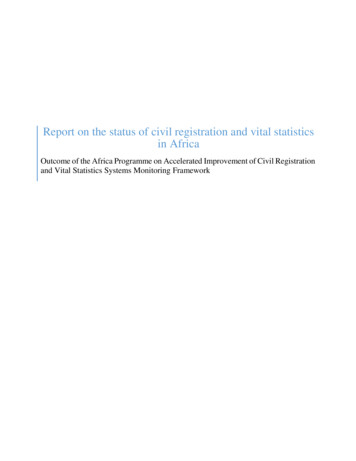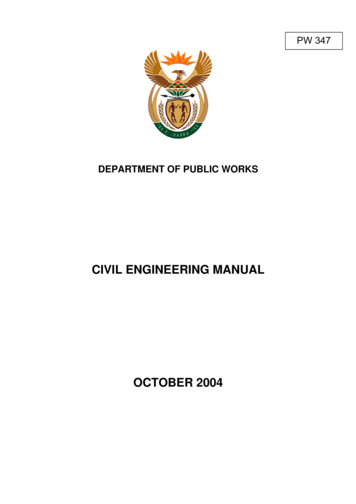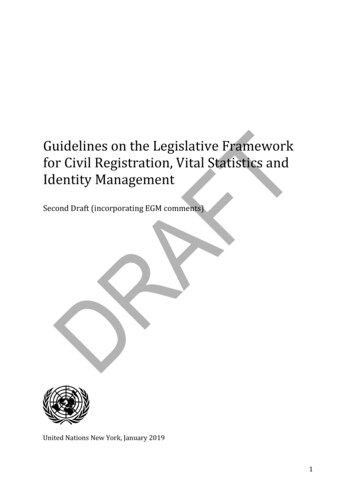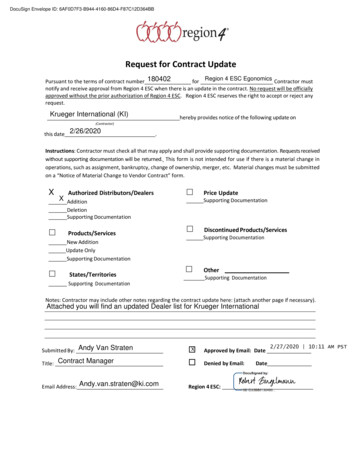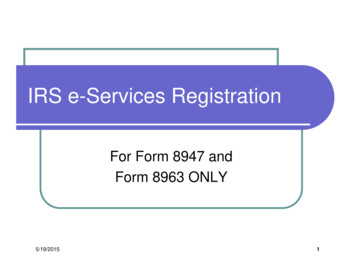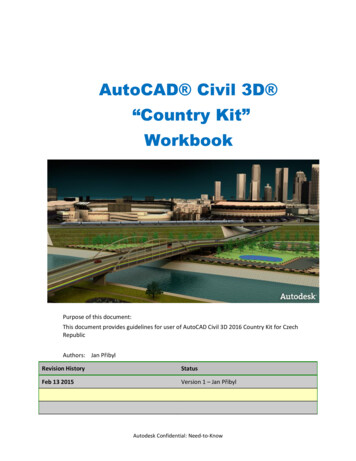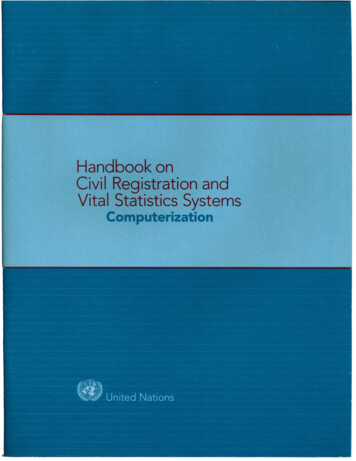
Transcription
Handbook onCivil Registration andVital Statistics SystemsComputerization
Department of Economic and Social Affairs· Statistics Division ST/ESAISTAT/SER.F/73Handbooks onCivil Registration andVital Statistics SystemsStudies in MethodsSeries F, No. 731111111.'I"'T.1 lIPII IIImn 1111 lun 11 111111 U1Handbook onCivil Registration andVital Statistics SystemsComputerizationUnited NationsNew York, 199811111,lUIm1111TIll
NOTEThe designationsernployed and the presentation of the material in this publication do not imply the expression of any opinion whatsoever on the part of the Secretariat of the United Nations concerning the legal status of any country. territory, city or areaor of its authorities, or concerning the delimitation of its frontiers or boundaries.STIESNSTATISER.Fn3UNITED NATIONS PUBLICATIONSales No. E.98.XVII.IOISBN 92-1-161403-1Copyright" United Nations 1998AIl rights reserved
CONTENTSPreface . . . . . . . . . . . . . . . . . . . . . . . . . . . . . . . . . . . . . . . . .Introduction . . . . . . . . . . . . . . . . . . . . . . . . . . . . . . . . . . . . . . .I.Framework of civil registration -and vital statistics systems. . . . . . . . . .A.B.C.D.fl.Overview of .computerization and automation stages in civn registrationand vital statistics systems in various countries . . . . . . . . . . . . . . .A.B.C.D.m.Defmition of civil registration . . . . . . . . . . . . . . . . . . . . . . . .1. Uses of vital records . . . . . . . . . . . . . . . . . . . . . . . . . . .2. Effect of computerization . . . . . . . . . . . . . . . . . . . . . . . .Definition of a civil registration system and vital statistics system. . . . . .1. Civil registration system. . . . . . . . . . . . . . . . . . . . . .'. . .2. Vital statistics system . . . . . . . . . . . . . . . . . . . . . . . . . .Interface between civil registration and vital statistics. . . . . . . . . . . .1. Completeness and timeliness . . . . . . . . . . . . . . . . . . . . . .2. Codification.3. Extractions from administrative registers . . . . . . . . . . . . . . . .Implementation of computerized civil registration and vital statistics systemsIntroduction.Some first choices. . . . . . . . . . . . . . . . . . . . . . . . . . . . . . .1. Automated index. . . . . . . . . . . . . . . . . . . . . . . . . . . . .2. M i c r o f i l m . . . . . . . . . . . . . . . . . . . . . . . . . . . . . . . .3. Optical disk technology . . . . . . . . . . . . . . . . . . . . . . . . .4. Numbering systems . . . . . . .' . . . . . . . . . . . . . . . . . . . .5. Some examples from the United States of America . . . . . . . . . . .6. Implications of frrst choices. . . . . . . . . . . . . . . . . . . . . .Available software . . . . . . . . . . . . . . . . . . . . . . . . . . . . . .1. Electronic birth record. . . . . . . . . . . . . . . . . . . . . . . . . .2. Electronic death record . . . . . . . . . . . . . . . . . . . . . . . . .Phased approach to the computerization of civil registration andvital statistics systems. . . . . . . . . . . . . . . . . . . . . . . . . . . . .Overview of major decisions and problem areas of computerization. . . . .A.B.Introduction.Major decisions. . . . . . . . . . . . . . . . . . . . . . . . . . . . . . . .1. Derming the framework of civil registration and vital statistics systems2. Derming the unique key to be used in the civil registration system. . 313131313
3.4.5.6.7.8.9.IV.ParagraphsPageDefining the objectives and purposes of computerization. · · · ·96-97Establishing the organization that will handle computerization.· 98-100Deciding on overall development strategy and operational strategy ·101-104Hardware configuration and procurement. · · · ·· · · · 105Inviting external contracts.106··.· ·.· ··· · ··Choosing a conversion/initialization strategy . · · · · · · · ·107-108System functionality. · · . · ·· · · · · · · 424183-232183-1872525······ · ·Purpose of computerization · · · · · · · · ·· ····· · ·A. Introduction. · ···.····· · · ·. · ·········B. Improvement of civil registration data . · · · · · . ··· · ·· ·C. Coordination and integration . · · · · · ·· · ·· · · · ··D. Unique registration cumber .·· ······ · · ·····1. Person identification number. using speciflc personal information.·2.E.Person identification number .using specific personal anddemographic infonnation. · · · · ···Other benefits . · · · · . · · · · · · · · · · ·· ·· · ···1. Automated issuance of certificate copies . · .· · ···· ·· ·2. Security of computerized civil registration data. ···· ··3, Misuse by administrators Qf the civil registration/vital. statistics register4. Operator access restriction.·· · ··.········5. Introducing the popUlation register.··· ··Coordination and integration of vital statistics data·· ······.·· ····.· ····Project phases .· · · · · · · · · · . · · . · · · · · · · · · · · · ·A. Introduction . · . · · · · · · · · · . · · · . · · · · . · .··B. Advance planning: feasibility study · · · · · . ·· · · ·1. Systems in place . · . · · · · .········ . ·. ·. · ·2. Framework of the computerized system.F.V.··.",·········3. Organization and management · ···· ······· ····4. Legislation. · · . · · · · ·.···.······ ···5. Mechanics of the future system . · · . · · ·· . ···6. Master plan for implementation. · · .C. Bid· and contract . · . · · ··· . ···· ·· ··D. System evaluation and acquisition . · · ··. · ······1. Acceptance tests . .······ · ··.··· ·. ··2. Contract · · · · . · · · · · · . · · . · · · · · · · · · · . · · ·3. System development. · . · · . ·· ··· ··· ·.···E. Next phases . · · . · · · · · · ··.··VI.····.· · ······.········ · ·.· ·.· ·.· .··.······· ··.·· ··· ··.···.···. ·Organizing computerization . · ·· ···. ···········. ···. ·A. Introduction. .·.··· ·········· ·· ···· ·· ·.···iv
828282829292930303131313131VII. Initializing the civil registration register . . . . . . . . . . . . . . . . . . . . ganizational structures of civil registration . . . . . . . . . . . . .1. Principal centralized system. . . . . . . . . . . . . . . . . . . . . . .2. Other centralized systems . . . . . . . . . . . . . . . . . . . . . . .3. Decentralized systems. . . . . . . . . . . . . . . . . . . . . . . . . .4. Local registration authorities . . . . . . . . . . . . . . . . . . . . . .C. Overall organizational structures. . . . . . . . . . . . . . . . . . . .1. Main active partners. . . . . . . . . . . . . . . . . . . . . . .2. Civil registration agency. . . . . . . . . . . . . . . . . . . . . . . . .3. Local clvilregistries. . . . . . . . . . . . . .4. Basic authorities. . . . . . . . . . . . . . . . . . . . . . . . . . . . .5. Individual residents . . . . . . . . . . . . . . . . . . . . . : . . . . .6. Other active partners. . . . . . . . . . . . . . . . . . . . . . . . . . .D. Recommendations concerning the general structure of civil registration . .1. Civil registration agency. . . . . . . . . . . . . . . . . . . . . . . . .2. Local civil registries. . . . . . . . . . . . . . . . . . . . . . . . . . .3. Basic authorities . . . . . . . . . . . . . . . . . . . . . . . . . . . . . .E. Organizational structures during advance planning and system development1. Overall structure. . . . . . . . . . . . . . . . . . . . . . . . .2. Steering group . . . . . . . . . . . . . . . . . . . . . . . . . . . . . .3. Reference group . . . . . . . . . . . . . . . . . . . . . . . . . . . . .4. Project organization . . . . . . . . . . . . . . . . . . . . . . . . . . .5. Basic organization . . . . . . . . . . . . . . . . . . . . . . . . . . . .F. Organization after system implementation . . . . . . . . . . . . . . . . . .1. Computer centre. . . . . . . . . . . . . . . . . . . . . . . . .2. Reference group . . . . . . . . . . . . . . . . . . . . . . . . . . . . .3. ugalsection . . . . . . . . . . . . . . . . . . . . . . . . . . . . . . . .4. Utilization section . . . . . . . . . . . . . . . . . . . . . . . . .5. Security section . . . . . . . . . . . . . . . . . . . . . . . . .G. Organizational structures of vital statistics. . . . . . . . . . . . . . . . . .A.B.C.D.VIn.Why initialize the civil registration register? . . . . . . . . . . . . . . . .How to initialize the civil registration register . . . . . . . . . . . . . . . .1. Conversion of data already existing on electronic media. . . . . . . .2. Manual entry of information from existing vital records and documents3. Collection of information within the population and manual entering. .Time-frame from initialization to operation . . . . . . . . . . . . . . . . . . . . . . . . . . . . . . .Archiving paper-based forms. . . . . .System functionality and requirements. .A. . .Software requirements. functionality and design. . . . . . . . . . . . . . .1. Events and tabulations . . . . . . . . . . . . . . . . . . . . . . . . . .v
Logical data entities and their data items . . . . . . . . . . . . . . . .3. On-line functions and functionality . . . . . . . . . . . . . . . . . .4. Validations. business rules and procedures . . . . . . . . . . . . . . .5. Civil registration and vital statistics interface and other utilities . . . .Hardware requirements. . . . . . . . . . . . . . . . . . . . . . . . . . . .Security system requirements. . . . . . . . . . . . . . . . . . . . . . . . ., 1. Physical damage. . . .'. . . . . . . . . . . . . . . . . . . . . .' . .2."· War . , . ',' . '. .3. Misuse of information. . . . . . . . . . . . . . . . . . . . . . . . .4. Misuse by administrators of the civil registration and vital statisticsregister. . . . . .'," . . . .5. Operator access restriction . . . . . . . . . . . . . . . . . . . . . . . .Functionality of the vital statistics system . . . . . . . . . . . . . . . . .1. Error search programs. . . . . . . . . . . . . . . . . . . . . . . .2. Storage of data. . . . . . . . . . . . . . . . . . . . . . . . . . . . .' '.3. Tools for analysis of data . . . . . . . . . . . . . . . . . . . . . . . .Summary . . . . . . . . . . . . . . . . . . . . . . . . . . . . . . . . . . 8285286287·290288289290291-293393939393939. 39AnnexesI. Definition of civil events . . . . . . . . . . . . . . . . . . . . . . . . . .' .n. Defmition of standard population event registration . . . . . . . . . . . . .m. Definition of recommended vital statistics tabulations. . . . . . . . . . . .IV. Sample table of contents for civil registration feasibility study '. . . . . . .V. Logical entities and their data items in the civil registration system .' .VI. Decision process for choice of initialization method. . . . . . . . . . . .vn. Case study: computerization of the civil status and vital statistics systemsof Seychelles and their integration with the National Population DatabaseAppendix I.Structure of the National Population Database . . . . . . .Appendex n. National Population Database user guide. . . . . . . . . .Appendix m. List of data fields in the National 'Population Database. . .'Appendix IV. Seychelles national identity card: application form, (new/renewal).vm. Case study: computerization-of the civil registration' system in S ot1and. .References. . . . . . . . . . . . . . . . . . . . . . . . . . . . . .vi:. .".". .40414244454849535458596067
PREFACEThe present Handbook on Civil Registrationand the UNFPA country support teams. Financialsupport has mainly been· provided by UNFPA.and Vital Statistics Systems: Computerization provides.guidance to decision makers and the relevantA vital part of the International Programmeauthorities of countries for the development and imwas the convening of five workshops between 1991plementation of administrative electronic dataand 1995, with the participation of senior civil regprocessing systems for civil registration and vi listration . experts and statisticians from specificstatistics systems. The Handbook focuses on gUIdcountries and regions in the world. The workshopsing the advance process and analysis leading toserved as a forum for exchange of information andsuch computerization, and offers a number of opexperience between member States, and adoptedtions for countries to consider, including model orseveral resolutions to support the improvement ofganization structures for planning; implementingcivil registration and vital statistics systems in eachand maintaining the computerization. It examinesregion of the world, which are included in the rethe framework, goals and purposes of the computports of the workshops. Ierization of civil1"egistration, looks: at the interfaceIn continuation of the International Probetween civil registration; the vital statistics systemgramme and with financial support from UNFPA.and other governmental agencies. and enumeratesthe United Nations Statistics Division has preparedsome of the major decisions and problem areas thata series of five subject specific handbooks to assistcan'be anticipated. in a move to computerization. Itcountries in improving their civil registration andis the experience of several countries that the sucvital statistics systems. as· follows:cess of computerization depends on organiZation,advance planning and clear decisions and goals far . (a) Handbook on Civil Registration and Vital Statistics Systems: Management, Operation andmore than on technical matters. Dlustrations fromMaintenance the,systems f a Qumber()f countries are used in theanalysis. The present Handbook gives priority to a .(b) Handbook on Civil Registration and Vital Stasys.tem concept ,according to which the. registrationtistics Systems: Preparation of a LegalFramework .of vital events takes place in the: civil registrationsystem, which by,extractionfromtbe database de(c) Handbook on Civil Registration and Vital Stalivers the required data to the vital statistics systemtistics Systems: Developing Information,for statistical treatment. The Handbook has beenCommunication and Education;prepared as part of the International Programme for(d) Handbook on Civil Registration and Vital StaAccelerating the ImprovetnentofCivil Registrationtistics Systems: Policies and Protocols for theand Vital Statistics' Systems.Release and Archiving of Individual Records;The International Programme was desi.gned(e) The present Handbook.by the United Natlons Statistics Division. theUnited Nations PopUlation Fund (UNFPA), theWorld Health.·Organization and th InternationalISee report of a Latin American worksbop on strategies for accelerInstitute for VitalRegistration and Statistics. It wasating the improvement of civil registration and vital statistics systems.Buenos Aires, 2-6 December 1991, pp. 18 to 23; report of a westernadopted by the Statistical Commission at itsAsia workshop on strategies fouccelemting the improvement of civiltwenty-fifth and twenty ixthse.Ssions, in 1989 andregistration and vital statistics systems. Damascus. 20-24 June 1993;1991. The International Programme encouragesreport of an East and South Asia workshop on strategies for accelerating the improvement of civil registration and vital statisti s systems.countries to undertake long-term self-sustainingBeijing. 29 November - 3 December 1993; report on an Afncan workprogrammes of reforms to strengthen their civil regshop for English-speaking countries on strategies for accelerating eistration and vital statistics systems. It is being imimprovement of civil registration and vital statistics systems. AddisAbaba, 5-9 December 1994; report of an African workshop forplemented in phases by the United NationsFrench-speaking countries on strategies for accelerating the improveStatistics Division, focal point for the Programme,ment of civil registration and vital statistics systems, Rabat, 4-8December 1995.with the cooperation of the regional commissionsvii
Readers are encouraged to c.onsult all fiveHandbooks, including the present Handbook and itsannexes and references.The present Handbook describes in its eightchapters the activities that countries should carryout to tailor their own civil registration system totheir specific historical, demographic, legal and administrative conditions at the time of computerization of such a complex system. Only in this waywill countries benefit from the investment made incomputerization.A phased approach is suggested for the computerization of civil" registration and vital statisticssystems. One suggested scenario for phased computerization would fie each phase to- specific vitaland civil status events. beginning with basic vitalevents and-if countries '0 wish and resourcespermit--culmmating in' a population registrationsystem. The importattce''Of initializing die computerized system with population Status data is a keyelement of the present Handbook. It is anticipatedthat the concepts presented in the text and the annexes will be helpful in easing the process of computerization of the civil registration system. TheHandbook should inspire' the responsible authorities to analyse the administration inplace and'Carryout the computerization. based OIL the actual statusof each specific country.The present Handbook looks at some of theeffects that computerization will have on civil regis.tration, including the possibility of developing aunique personal identification number as the key t.Othe system. The computerization of civil registration willcequire uniquely identifying each individual and ensuring that each and every vital event isrecorded once and only once, in both the civil registration and vital statistics systems. It recommends,for example. that countries follow a process thatleads to a unique numbering system to track the records of its vital events. However, a recommendation on the appointment of the unique petsonalidentification number as the national identificationnumber for each individual in the country is beyondthe scope of the present Handbook.Some of'the ex:amples used in the Handbookare taken from countries where population registersare closely linked with the civil registration system.In -some cases, the numbering system for civil registration is closely tied to the personal identificationnumber used to update information on individualsin the population register. As with cases in whichthe civil 'registration system is not tied to the population register, the examples provided are meant tobe illustrative ofthe computeri,zationprocess ratherthan to recommend a particular course of action.The Handbook concludes by considering some ofthe security measures needed by the two systems toensure confidentiality and the preservation of data.It also outlines the requirements of the hardwareand software needed to operate and maintain thesystems.It should be realized that a computerizedcivil registration system is not merely an electronicregistration of chronological series of vital eyentsand their retrieval. Indeed, computerization of thecivil registration system means much more. thanmerely doing electronically what is being donemanually by the present struCture.f or else it wouldnot be an important and usefutsubstitute for amanual civHregistration system. Accordingly. it would.be a great mistake to consider the computerization,of such complex systems as civil registration andvital statistics as a mere technical matter that can beachieved by any country.The target groups. of the present Handbookare made up' of countries with: (a) very differenttechnological practice. experience and skills; (b)very different legal and administrative practices;and (c) different financialmeandor accomplishinga computerization project. In addition, targetgroups range from countries with only manual registr!.lJionprocedures to countries that have initiatedcomputerization partly or to a',great extent. Becauseof that diversity of scenarios, at the. country, leve.!.the Handbook avoids step-by-step instructions for aparticular computerized civil· registration system;the usefulness of the Handbook would be very: limited if only one definite concept and one set of pro.,.cedures to be followed were given.The present Handbook was prepared by theUnited Nations Statistics Division, with the assistance of-eSC DataCentra!enof Denmark. a consultant for this purpose. A final review and revision ofthe Handbook from a technic.al anl'J editorial pointof view was conducted by Mr.l!)seph CameY3 Director of the Division of Health Slatisticsand VitalRecords. eoforado Oepartnl nt of PUblic Healthand Environment. Expert advice inthe preparationof the Handbook is gratefully acknowledged fromMr. Bent Dall. Project Manag r. esc DataCen.tralen; Mrs. Jane Bloch, CSC Oam'Centralen; andMr. Jose.ph Carney, United. States of America. TheUnited Nations is also gratefUlto Mr. Davi4 B. L.Brownlee of th.e Gen.eral Register Office for Scotland, and Mr. O. P. Ah-ShUllg, Electoral COmmissioner and Chief Officer or: the Civil Status Government of Seychelles. for their c.pntributionsviii
with case studies to the present Handbook. The fol.lowing bodies and indi viduals are alSo acknowledgedfor their commments on the manuscript: Ms. Pamela Aldsson, Director of the Bureau of ProductionSystems and Management, New York State Department of Health; Ms. Dorothy S. Harshbarger, StateRegistrar'and Director, Center for Health Statistics,Alabama Department of Public Health; Health Statistics and Vital Records Division, Colorado Department of Health and Enviroment; Mr. VitoLogrilIo, Director, School of Public Health, NewYork State University; Mr. Duy Man Vu, ProjectCoordinator, Computer Software in Support forPopulation Activities, United Nations Statistics Division; Mrs. Violeta Gonzales Diaz, Statistician,United Nations Statistics Division; Mr. PatrickGerland, Software Specialist, United Nations Statistics Division; Mr. Uwe Deichmann, TechnicalSpecialist, Geographic Information Systems andComputer Mapping, United Nations Statistics Division; and Mr. Djamal.:.Eddine Benzine, United Nations Statistics Division.ix
INTRODUCTION1.The present Handbook on Civil Registra·tion and VitalStatistics Systems: Computerizationis divided into eight chapters, as described below.goal. A project to computerize the civil registrationindexes in Scotland is used throughout the chapterto illustrate the phases.2. ChlJ:pter I outlines the key purposes andgoals of civil registration and vital statistics sys·terns. It looks at some Qfthe effects thatcomputeri·zatioJ). will ,have on civil registration, including thepossibility ofdeveloping a llnique:personal identifi·catioJlnllmberas the key to the system. The chapterthen examines the key are3.s of interface betweenthe -civil registration and- vital statistics systems.With reference to irnplernentiug the computerizedsystem, chapter lteconunends a phased approach.7.Computerizatlon·ofthe civil registrationsystem need not be limited to doing electronicallywhat is being done manually by the present struc·ture. Chapter VI considers the issues surroundingthe current strUcture of civil registration withincountries and what implications computerizationcan have on that structure. It gives specific recommendations concerning the type of strUcture to beused for both the advance planning and system de·velopment phases. as well as for basic organizationafter system implementation.3.Chapter n provides an overview of thedifferent stages O.f computerization. and discussesthe computerization of individual portions of thecivil registration ·system for countries that may notbe in aposition-toattempl full implementation. Thechapter concludes with more detailed informationconcerning the reconunendcd phased approach,Chaptermenumerates some of the major4.decisions and problem areas anticipated in-a moveto computerization. It specifically outlines ninemajor decision points that need to be anticipated,whether considering partial or complete computeri·zation.5; Chapter IV examines-the pmposeof computerizing the civil registration system. includingits effect on the vital statistics system and othergovernmental agencies. The chapter looks at theoption of using· a· personal identlfkation numberand considers the benefits to -be reaped from com·puterizationofciviI registration.6.Chapter V lists the phases to be includedin a computerization project. whether the countryhas a full.;.scale- project or a partial project as its8.The principal focus of chapter vn is thetransition from the civil registration system beforecomputerization to the civil registration system afterimplementation. It introduces the concept of "initialization" of the system, and outlines the proceduresnecessary to avoid a register that divides the popula·tion into those reported and those not reported.9.The Handbook concludes by looking athardware and software requirements in relation tothe functionality that the country -desires to obtainfrom the computerization of its civil registrationsystem. It considers isstres.surrounding the extrac·tion of data from the civil registration system foruse in the vital statistics system. Chapter vm alsooutlines some of the security measures needed bythe two systems.10. Crucial to the impact of the presentHandbook are its annexes; it is recommended thatthe reader consult each carefully. Of particular sig.nificance are annexes VIT, which contains an illustration of computerization in Seychelles, and vm,which describes the progress of computerization inScotland in recent years.1
I. FRAMEWORK OF CML REGISTRATIONAND VITAL STATISTICS SYSTEMSA.2. Effectofcomp«t rizmionDE.FINITION OF CIVIL REGlSTRATION. 11. The U ited Nations defines civil registratlon s the contlOYOus. pennanentt compulsory recordmg of the occurrence. and ch.aracteristics ofvital events, . and as pxovided,(brough decree ofregul tion. in accordance with. the leg!1l. requirement m eachcDuntry. Civil registration,is carriedout primarily forthe,valueofthe,jegal documents asprovided by law. However. the usefulness.of theserecordsas.As.o1U'ceof st Jisticsjsbecomingjncreas ingty recogni.zed".2 There is also a 'frameworkwithin·which civiI,regi.strationexists, That framework Sho?ld cover all vital events occurring in allgeographlc areas and all population groups in thenational.area. CivilregisJtation should include livebirths. deaths. foetal deaths. marriages and divorces, An ultimate goal is to also. include, annulments. judicial separations. adoptions, legitimationsand recognitions,1.Uses of vital recordsCivil registration has many:, uses. Birthprovide, indi iduals: with; leg proof oftdenuty. age; Olltlonalit.y and. parentage The:reco.r.d12. c or sc dcllstody Wld. (iPt cJe.d,uctions. A death recordcand fy inhetitance11ghts. proper 'Claim to insurance benefits B?d thedght of'the: surviving spouseto reItUU'1'.Y. 1:1sts of de:aths can be used to purgevoter registratIOn rolls and to close' out retirementbenefits. DivorcerecOl::ds1U'e also important for establishing the right to remarry. Marriage recordscan eusedf restab ishingtax deductions, provingthe nght-to-ahmony. In the event of' livorce andestablishingclaim to property in the,eventcfthepartner's death. Uses: of aggregated· data· from civilre8i;su:ation· includ population estimates, healthstatistics and demographic forecasts.2 eePrlnclptes JJ1IfJ ecl1mmenda1iQns for "Vital Swtlslics System.StatistiCal Pa rs. Senes M. No. 19. Rev.1 (United Nations publicati()D - Sales No. E.90;XVII:9). para. 278.13. Computerizing civil regtstration willh e a. um r of ef ects. When computerizingcIvil te SfratlOn. a dIfferent vtewpoint is taKen;:n. tr gistraUo systenn mrceptfQCllse"SonthelOdlvldtml:as the malO key to tbJ!cCivil events information linldng all registratiO-lls to' the. indivi"dual.BY' establishing: this linkage. the:' civil' (egistrationsystem is ftom the, very first v rsion prepar d forfutur changesanel; @ditions. the'pre"S mt chapterdeS"cnbes and rec.ommendS:: S;'{lhased: system:cf im Iementation. Aggregate'(lcrataftomcivilregistra t10 pr?duc.es vital atistics {Of {1se: in pop"UlationproJectlons and c stJmates. health and populationpr.p es.14. The computerization of civil registrationwill broaden tOe. uses that ·CJlll be made of the civilr gist1'ation system. Link.age of'the civil istra tton system to other-computerized systems will become PQ.:ssible. It will become:, more impo rtattt touniqttely id.entifyea h individual . and to ensJ.U:e th.ateach and. every, event is recorded once ancI onlyo?c.e. Ul.bo.th the civil registtlllion system: M4 theVltal statistICs system. Iss.uance of a unique, registration or personal identification number, shouldtake place at theti.me at Howthisis.dQne witlvatyfrom. system to system and. {rom country to country. oweyer, t e appointment of the unique personalldentlficatlQn number as the national identification number for each indiVidUal is a subjectthat m t be cat:ef.ulIy as.sesse :\1by the' competentauthontleS t and IS beyond .the scope'of the: presentHa
of vital events takes place in the: civil registration system, which by,extractionfromtbe database de livers the required data to the vital statistics system for statistical treatment. The Handbook has been prepared as part of the International Programme for Accelerating the ImprovetnentofCivil Registration and Vital Statistics' Systems.
